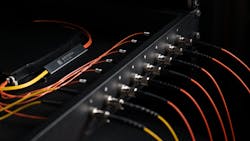Converting media from multimode to singlemode
By Kevin Lenglé, PhD, Cailabs
Media converters are an essential tool for IT networks. Every network professional has probably already used one and should always have a spare on hand. They provide connectivity over heterogeneous networks. Media converters are mainly used to connect copper and fiber networks, but there is a growing need to link singlemode and multimode optical fiber networks. The latest technological developments now allow this function to be completely passive, i.e. without requiring a power supply. This article explains how it can be done.
Swiss Army knife of LANs
There are many different types of network cables: coaxial, copper twisted pair and optical fiber, both multimode and singlemode. A media converter is a device used to connect different cabling technologies that would otherwise be incompatible. Media converters were introduced to the industry in the 1990s and have played a major role in enabling the connection between fiber-based and copper-based structured cabling systems. Media converters have increased in popularity in recent years because of their cost efficiency and flexibility to connect different types of network media. Originally used mainly in local area networks (LANs), media converters have become a ubiquitous tool for many different network types. Local networks are extending over an ever-wider area. Successive expansions and upgrades mean that campus structured cabling networks often combine different types of media. In a context of digital convergence, and with the emergence of new services that generally consume a lot of bandwidth, it is becoming essential to achieve good connectivity on heterogeneous networks. However, budget constraints are forcing network managers to maintain previous investments in their cabling infrastructure. This is why the media converter has become the Swiss Army knife of networks.
Media converters are widely used and deployed in all economic sectors to provide the communications that have become vital in our connected world. Industry, healthcare, entertainment and public services—these are just a few examples of where this small device can make a big difference in terms of network infrastructure performance and efficiency. Although the environment in which the media converter is installed may vary, the operating principle remains the same: to provide a seamless fit between two different transmission media.
Conventional active equipment
Media converters are mostly compact standalone units, or converters that can be installed in a variety of chassis configurations. This type of chassis features multiple power supplies for redundant power and data protection to deliver flexible and scalable connectivity. A media converter supports different types of data protocols and throughput (10 Mbits/sec to 10 Gbits/sec) with the aim of creating more reliable and cost-effective networks. Their small footprint allows media converters to be installed anywhere—in offices, cabinets, telecom rooms and datacenters.
Conventional media converters are usually physical layer devices (Layer 1 of the OSI model). They only convert signals on physical media, so they are completely transparent to data. Media converters are known as plug-and-play devices. However, you still need to consider certain factors when connecting them to networks, such as temperature and humidity which must be kept within an appropriate range for a smooth operation. There are different grades of media converter, depending on the temperature and humidity levels in the location where the device will be installed. It is therefore possible to install it in an area with harsh environmental conditions, but you should take the necessary precautions beforehand.
Ubiquitous need for MM to SM conversion
In addition to copper-to-fiber conversion, the latest generation of media converters can be used to link multimode and singlemode fiber networks. Due to fiber’s numerous benefits, the LAN backbone has become predominantly fiber-based, and there are many situations where multimode-to-singlemode (MM-SM) conversion is required for campus networks.
MM-SM media conversion is required to connect new generation singlemode equipment across aging multimode fiber cabling networks. This type of conversion is also required to connect an operator access network and a customer local area network, for example. A media converter is required to link the singlemode operator network and the customer premises equipment, which is typically within a multimode fiber-based network. For the past 40 years, the optical cabling deployed in LANs has consisted mainly of multimode fiber. However, the declining costs of singlemode transceivers in recent years, combined with the enormous bandwidth offered by singlemode cabling, have made singlemode fiber a more sustainable option for campus structured cabling to meet the current and future throughput requirements of LANs. Another example of MM-SM conversion is for campus extensions. The newer campus area consisting of a singlemode fiber backbone must be able to connect to the existing cabling infrastructure, generally consisting of multimode fiber. These examples show that multimode-to-singlemode media conversion has become essential for LANs. It should also be noted that, as throughput rates increase in the LAN, this specific function is no longer only provided by conventional media converters for data rates of 10+ Gbits/sec because network managers are increasingly using switches to ensure the MM-SM transition. This results in the underutilization of certain active network resources to perform this "simple" MM-MS conversion function. So, are no other technological means currently available?
A new type of passive media converter
Optical technologies have evolved in recent years and it is now possible to perform MM-SM conversion in a completely passive manner. Let's take a closer look at how it works.
Typically, due to its intrinsic geometric and optical properties, conventional OM1-2-3-4-5 multimode fiber can support dozens of modes. Each mode will travel along a different optical path inside the optical fiber. Conversely, singlemode fibers have an optical core that is small enough to allow the propagation of only one mode. Therefore, to ensure efficient conversion, the SMF mode must optically coincide with the fundamental mode of multimode fiber through an efficient modal adapter.
To achieve this, efficient light shaping techniques are available on the market. Today, these technologies provide comprehensive and flexible beam shaping with very limited optical losses, using a succession of very complex optical lenses. These technologies shape the laser signal in order to excite distinct modes in the multimode optical fiber core. It is therefore possible to excite only the fundamental mode of the MMF and use it as an independent transmission channel with the same transmission properties as a singlemode fiber. Consequently, this type of media converter can be installed between a singlemode fiber and a multimode fiber, regardless of the type of MMF—62.5/125 µm or 50/125 µm.
In addition, this transparent transmission of optical signals between singlemode and multimode fiber is completely passive. These new technologies are composed solely of optical elements, and therefore do not require power or monitoring, unlike conventional media converters. This removes an intermediate active layer on this type of MM-MS hybrid link. To enable these adapted links, singlemode transceivers are used on either side of the link, similar to a standard SMF link.
The complexity and heterogeneous nature of today's networks, bandwidth-intensive applications and the increasing number of connected devices increase the performance requirements of cabling infrastructure. But, while the idea of a passive media converter sounds promising, what about the bandwidth limitation of multimode fiber? How does it fit into this scenario?
Converter boosts MMF bandwidth
Singlemode optical fiber is known to have a very high bandwidth. It is used to transmit data at very high throughput rates over very long distances. Conversely, multimode fibers have limited bandwidth, so their transmission capacity is reduced. As explained above, the multimode optical fibers predominantly deployed in LANs are typically able to transmit several modes (optical paths). Multimode fibers therefore suffer from modal dispersion, a distortion mechanism that limits data throughput over a given distance. Today, building-to-building links on a campus require a throughput of 10 to 40 Gbits/sec. For example, data transmission at 10 Gbits/sec will barely exceed a few hundred meters on the latest generation fibers (OM3/OM4/OM5) and only a few dozen meters for first-generation multimode fibers (OM1/OM2). These multimode networks struggle to meet the increasing demands for bandwidth within the LAN.
The precise mode adaptation provided by this new type of passive media converter allows data to be injected directly into the fundamental mode of the MMF. It therefore also makes it possible to overcome the physical phenomenon of the modal dispersion that limits the bandwidth of multimode fibers. These new technologies have already proven their worth and effectiveness across numerous case studies around the world and today make it possible to transmit tens or even hundreds of Gbits/sec over legacy multimode fibers, thus avoiding the sometimes complex and often costly installation of new high-performance optical cables. This new type of media converter will therefore reduce capital expenditure by avoiding the deployment of new, latest-generation cabling equipment, which often requires intrusive work with a significant impact on the business activity of a campus. This new converter technology makes it possible to recycle the existing cabling infrastructure—one more step towards green IT, with proven benefits for end customers and ICT professionals.
Media converters are an essential tool for network infrastructure cost optimization. They allow administrators to reuse cabling infrastructure while offering a good quality service. In addition to copper-to-fiber network conversion, multimode-to-singlemode conversion has become an essential requirement for local networks, allowing different generations of optical infrastructures to coexist. As technology evolves, this conversion is totally passive and transparent from a throughput perspective, thus avoiding the cost, energy consumption and monitoring requirements of an intermediate active layer between heterogeneous MMF and SMF equipment. And, in addition to enabling passive MM-SM conversion, this new approach gives all multimode fibers the transmission capacity of a singlemode fiber. This solution will provide a new lease on life to aging LAN cabling while meeting the requirements for increased bandwidth.
Kevin Lenglé, PhD is product line manager for the AROONA product line at Cailabs.

